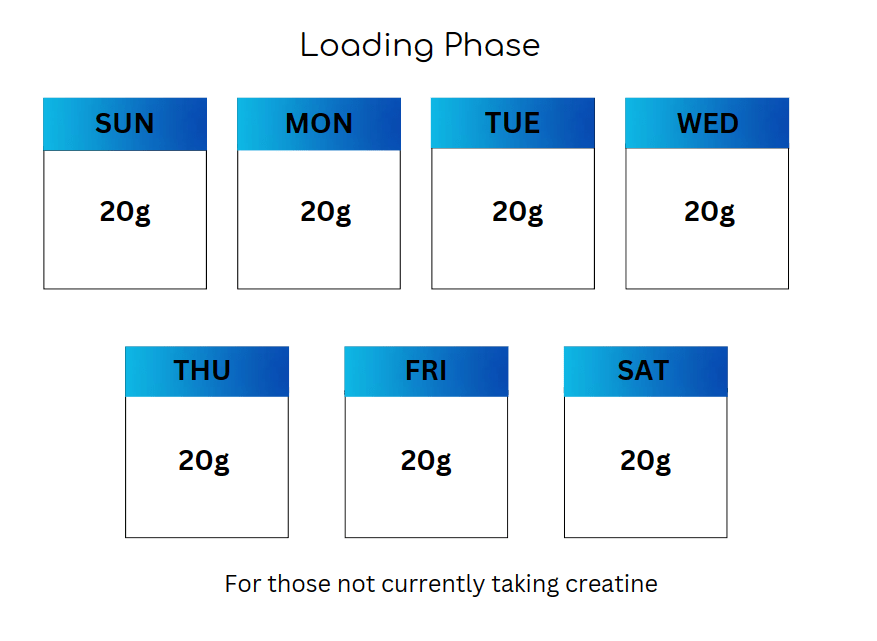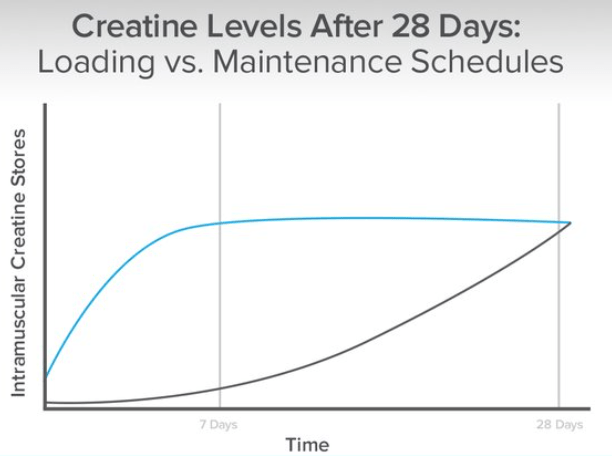Creatine Loading Phase
Welcome to the wild and wacky world of the creatine loading phase! Get ready to dive headfirst into the world of high-dose creatine supplementation and see just how much your muscles can absorb in a short period of time.
But seriously, the creatine loading phase is a common practice among athletes and bodybuilders looking to maximize their muscle creatine stores to improve strength and performance. It involves temporarily increasing the creatine dosage too much higher than usual to saturate the muscles with the compound.
But as with any supplement, there are potential risks and considerations to keep in mind when embarking on a creatine loading phase.
Will you end up with superhuman strength and the ability to bench press cars? Or will you just end up with a bloated stomach and some funky-smelling urine? Only one way to find out!
So buckle up, folks, because we’re about to embark on a wild ride through the world of creatine loading; get ready for some gains.
Table of Contents
| What is the creatine loading phase?
Benefits of the creatine loading phase |
|---|

What is the creatine loading phase?
Ah, the mysterious and often misunderstood creatine loading phase. You may have heard whispers about it in the gym or seen it mentioned in supplement advertisements, but what exactly is it, and why do people do it?
In a nutshell, the creatine loading phase is when an individual increases their intake of creatine to much higher levels than usual to saturate their muscles with the compound. The purpose of this phase is to rapidly increase muscle creatine stores, which may improve strength and performance during high-intensity exercise.
| It is usually done for 5-7 days, during which the individual takes a higher dosage of creatine, typically around 20-25 grams per day, divided into smaller doses taken throughout the day. |
|---|
But is the creatine loading phase necessary for everyone? Is it the be-all and end-all for boosting muscle strength and performance? And are there any potential risks or downsides to consider? These are all critical questions we’ll delve into as we continue this journey through the world of creatine supplementation.
Benefits of the creatine loading phase
First and foremost, one of the main benefits of the creatine loading phase is that it may help to increase muscle creatine stores rapidly. As we discussed earlier, creatine is a compound that produces ATP, the primary energy source for muscle contractions. Increasing muscle creatine stores may improve strength and performance during high-intensity exercises, such as weight lifting or sprinting.
Additionally, some research suggests that the creatine loading phase may help reduce muscle fatigue and improve recovery following exercise. This is likely due to the increased availability of ATP, which may help reduce the amount of fatigue-inducing byproducts produced during exercise.
It’s important to note that the specific benefits of the creatine loading phase may vary depending on the individual and the particular product being used. More research is needed to fully understand the mechanisms behind its effects and determine the optimal dosage and duration of use.
Potential side effects of the creatine loading phase
Creatine is a supplement that has been extensively studied for its potential performance-enhancing effects in athletes. While it is generally considered safe when taken at recommended doses, there are some possible side effects and safety considerations to keep in mind during the loading phase, which is the initial period of high-dose supplementation often recommended to saturate muscle creatine stores quickly.
One potential side effect of the loading phase is gastrointestinal discomfort, including bloating, diarrhea, and nausea. This can often be mitigated by taking smaller doses more frequently throughout the day or mixing the creatine with a carbohydrate-rich beverage or food.
Another concern with the loading phase is the potential for weight gain. Creatine can cause an increase in body weight due to its ability to retain water in muscle tissue. While this can be beneficial for athletic performance, it may not be desirable for individuals trying to lose or maintain a specific weight.
There have also been some concerns about the long-term safety of creatine supplementation, particularly regarding its potential effects on kidney function. However, numerous studies have found that creatine supplementation does not negatively affect kidney function in healthy individuals.
It is worth noting, however, that individuals with pre-existing kidney problems should consult with a healthcare professional before starting a creatine supplement regimen.
It is also important to note that creatine is not approved by the FDA as a dietary supplement. Its safety and efficacy have yet to be fully established in all populations. As with any supplement, it is crucial to speak with a healthcare professional before starting use.
While there are some potential side effects and safety considerations to be aware of during the loading phase of creatine supplementation, it is generally considered safe when taken at recommended doses in healthy individuals.

Conclusion
In conclusion, the creatine loading phase is a wild ride, folks. It’s like a rollercoaster of muscle-building awesomeness, but with the added benefit of not waiting in line for hours at an amusement park.
You can supercharge your muscles and become a beast in the weight room by chugging down high doses of creatine for a few days (or weeks, depending on who you ask). Just don’t be surprised if your muscles feel like they’re about to burst out of your skin – that’s just the creatine doing its thing.
So go ahead, load up on the creatine, and let your gains soar to new heights. Just make sure to hydrate because all that extra muscle mass is bound to make you sweat like a pig on a hot summer day.